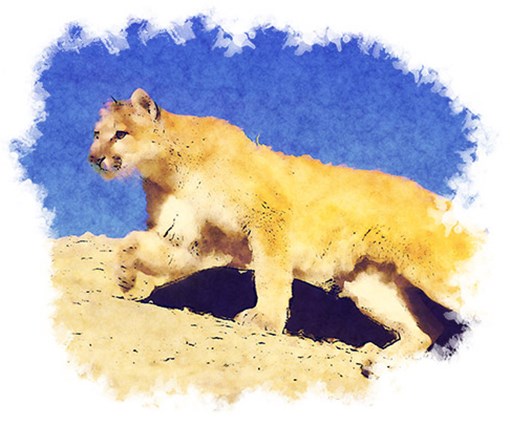
Also known as cougar, puma, panther, yellow cat, catamount, etc., the mountain lion is North America's largest member of the cat family. These majestic creatures once roamed throughout North America, but today, their range is limited to British Columbia and Alberta, Canada, the twelve westernmost states in the U.S., and Florida. These large cats, as adults, can be 30 inches in height at the shoulder, and approximately 8 feet long from nose to tip of tail. The tail of the mountain lion is about one-third the entire length of the body. Mountain lions usually weigh between 75-175 pounds. The largest mountain lion ever to be documented weighed 276 pounds, but a lion of this size is extremely rare. The coat of the mountain lion is light brown in color, and the fur is short and coarse. The underside of the cat is white, and the tail is tipped in black. Variations in the color of the lion's coat have been listed as rust, apricot, lemon, smoke, and even black.
Excessive hunting following European colonization of the Americas and the ongoing human development of mountain lion habitat has caused populations to drop in most parts of its historical range. Sighting a wild mountain lion is a rare and unexpected event. So unexpected that it's common for people to initially mistake them for deer even though the only things deer and mountain lions have in common are four legs and similar colored fur.

Range Map

Originally, mountain lions roamed throughout North and South America. Today in North America, lion populations are limited to British Columbia, Alberta, parts of Mexico, the twelve westernmost states in the U.S., and the Florida Everglades. Bounty hunting of mountain lions began as early as the 1600s in North America. Early settlers feared the mountain lions, and believed that the lions, as well as wolves and bears, had a negative effect on game populations. By the 1900s these predators had been killed in astonishing numbers, with a disastrous effect on the ecosystem in some areas. Loss of predators led to overpopulation of deer and other herbivores, resulting in overgrazing, increased erosion and decline in the long-term health of whole ecosystems. Bounty hunting continued across the nation until the 1960s, when efforts began to preserve environmental health. Mountain Lions survived the persecution better than other predators, yet mountain lion populations have not been restored in many areas. People are not always eager to help predator populations recover. Livestock losses are a source of concern because individual mountain lions have been documented wantonly killing dozens of sheep in a single night. As widely publicized as these accounts are, they do not occur regularly. However, because mountain lions are such successful predators (they can just as easily kill a bull elk as a domestic sheep), as long as there are plenty of deer for them to hunt they tend to leave livestock alone. Human InteractionAs a rule, mountain lions avoid people and signs of people, but in recent years, mountain lion attacks on humans have become a serious source of controversy. Although attacks on humans are extremely rare, the attacks have increased over the past few decades. As in most livestock depredations, the mountain lion that attacks a person is usually a hunger-crazed juvenile that has been pushed into marginal habitat by more dominant males. But it is human encroachment into mountain lion territory that creates marginal mountain lion habitat. As more people are recreating and living in rural areas, the chance of an encounter with these secretive animals is more likely. Nevertheless, by taking some precautions humans and mountain lions can coexist. Fast Facts
References
Threat Level provided by the International Union for Conservation of Nature's (IUCN) Red List.http://www.iucnredlist.org/
| ||
Last updated: December 14, 2022
